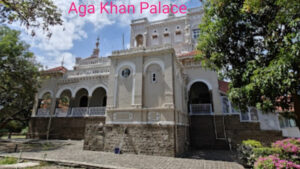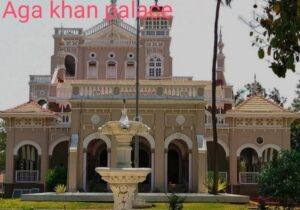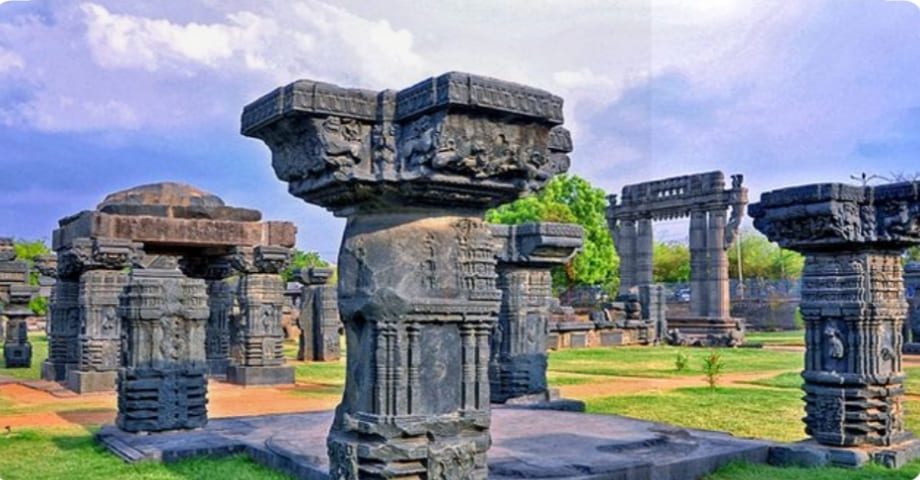The Aga Khan Palace in Pune stands as a magnificent symbol of India’s rich history and architectural brilliance. Known for its significant role during the Indian freedom struggle, this palace is not just a historical monument but also a testament to the timeless beauty and cultural heritage of India. In this blog post, we will delve into the architectural splendor, historical importance, and present-day relevance of Aga Khan Palace, offering readers a comprehensive insight into this iconic landmark.

1. The Architectural Brilliance of Aga Khan Palace
Aga Khan Palace is a masterpiece of architecture, blending elegance with functionality. Built in 1892 by Sultan Muhammed Shah Aga Khan III, the palace was designed with a blend of Italian and Indian architectural styles. The grand Italian arches, expansive lawns, and intricately designed interiors make the palace a visual delight.
Covering an area of approximately 19 acres, the palace features a series of spacious halls, each showcasing the exquisite craftsmanship of the time. The serene surroundings of the palace, coupled with its lush green gardens, provide a peaceful retreat from the hustle and bustle of the city. The architectural beauty of Aga Khan Palace is not just in its structure but also in the way it harmonizes with its natural surroundings, making it a true marvel of design.
2.Historical Background of Aga Khan Palace
The history of Aga Khan Palace is deeply intertwined with the humanitarian efforts of its founder, Sultan Muhammed Shah Aga Khan III. The palace was built during a severe famine in Pune, with the primary aim of providing employment to the local people. By commissioning this grand project, Aga Khan III not only created a landmark but also helped alleviate the suffering of many during that difficult time.
Over the years, the palace has witnessed numerous significant events, but it gained nationwide prominence during the Indian freedom struggle. Its role as a place of refuge and later as a prison for key leaders of the freedom movement marked a pivotal chapter in its history
3. Aga Khan Palace and the Indian Freedom Struggle
The most defining period in the history of Aga Khan Palace was during the Indian freedom struggle. In 1942, following the launch of the Quit India Movement, Mahatma Gandhi, his wife Kasturba Gandhi, and several other prominent leaders were imprisoned in the palace by the British government. This period of captivity marked a crucial phase in India’s fight for independence.
The palace became a witness to the trials and tribulations of these freedom fighters, including the tragic demise of Kasturba Gandhi and Mahadev Desai, Gandhi’s secretary, within its walls. Their sacrifice and the hardships they endured during their imprisonment have left an indelible mark on the palace’s history, making it a symbol of India’s struggle for freedom.
4. Kasturba Gandhi Memorial and Samadhi
Within the tranquil grounds of Aga Khan Palace lies a poignant reminder of the sacrifices made during the Indian freedom struggle—the memorial dedicated to Kasturba Gandhi. The samadhis (memorials) of Kasturba Gandhi and Mahadev Desai are located here, serving as solemn tributes to their memory.
These memorials are more than just monuments; they are symbols of the indomitable spirit and unwavering dedication of those who fought for India’s independence. Visitors to the palace often find themselves moved by the stories of courage and sacrifice that these samadhis represent, making it a place of reflection and reverence.

5. Aga Khan Palace Today: A Heritage Site and Museum
Today, Aga Khan Palace has been transformed into a museum that preserves the legacy of India’s freedom struggle. The museum houses various exhibits, including photographs, personal belongings of Mahatma Gandhi, and other artifacts related to the freedom movement. These exhibits offer a glimpse into the life and times of the people who played a crucial role in shaping India’s destiny.
The museum also serves as a center for promoting Gandhian principles and values, hosting events and activities that encourage visitors to reflect on the teachings of Mahatma Gandhi. The preservation of these historical artifacts within the palace ensures that future generations can continue to learn about and be inspired by India’s rich heritage.
6. The Palace Gardens: A Peaceful Retreat
One of the most enchanting features of Aga Khan Palace is its beautifully maintained gardens. These gardens, with their lush greenery and well-manicured lawns, provide a serene environment that complements the grandeur of the palace. The tranquil pathways, shaded by ancient trees, invite visitors to take a leisurely stroll and soak in the peaceful ambiance
The gardens also serve as a space for reflection, where visitors can sit and contemplate the historical significance of the palace and the events that took place within its walls. The combination of natural beauty and historical importance makes the palace gardens a perfect retreat for those seeking both inspiration and relaxation.
7. Visiting Aga Khan Palace: Essential Information
If you’re planning to visit Aga Khan Palace, here are some essential details to help you make the most of your trip
– Location: Aga Khan Palace is located in the Yerwada area of Pune, Maharashtra.
– Opening Hours:The palace is open to visitors from 9:00 AM to 5:30 PM daily.
– Ticket Prices:The entry fee is nominal, with discounts available for students and senior citizens.
– Best Time to Visit: The ideal time to visit the palace is during the cooler months from October to March when the weather is pleasant.
– Nearby Attractions: While in Pune, you can also explore other historical sites like Shaniwar Wada, Sinhagad Fort, and Osho Ashram.
Conclusion:
Aga Khan Palace stands as a beacon of India’s rich cultural and historical heritage. From its architectural brilliance to its role in the Indian freedom struggle, the palace is a testament to the resilience and spirit of the nation. Visiting Aga Khan Palace is not just about admiring a historical monument; it’s about connecting with the past and reflecting on the sacrifices that have shaped India’s present.
As we continue to preserve and honor such heritage sites, we ensure that the stories of courage, sacrifice, and determination live on, inspiring future generations to appreciate the rich history that defines our nation. So, the next time you’re in Pune, make sure to visit Aga Khan Palace and immerse yourself in the history and beauty of this iconic landmark.
FAQ:
1.Why is Aga Khan Palace famous?
2.What is the entry fee for Aga Khan Palace?
3.Why was Gandhi kept in Aga Khan Palace?
4.Aga khan palace timings
5.Aga khan palace entry fee
6.Aga Khan Palace photos
7.Aga Khan Palace information
8.Aga Khan Palace is open today


Pingback: Mattancherry Palace Kochi : Exploring The Best Kochi's Dutch and Portuguese Heritage - solotraveler